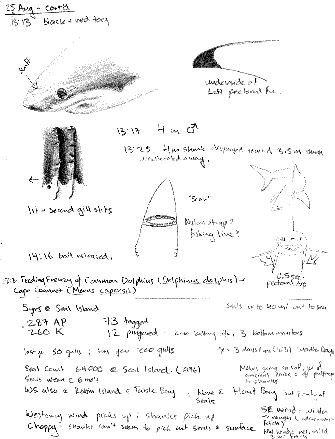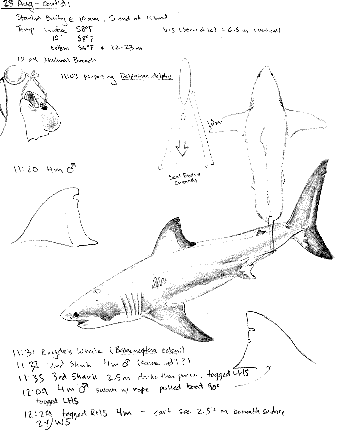Methods for Studying White Shark
Predatory Behavior at Seal Island

|

|
|
Pages from my field notebook, 25 August 2000, False Bay, South Africa. |
As part of a larger study instigated by Chris Fallows and Rob Lawrence of African Shark Eco-Charters, predator-prey interactions between White Sharks and Cape Fur Seals at Seal Island, False Bay, South Africa, were investigated by direct observations of ad libidem encounters between these two species at the surface during August and September 2000. Many of the methods adopted here were pioneered by Fallows and Lawrence. Observations were made from the platform of an 8-metre Butt-Cat boat equipped with paired Johnson 150 HP outboard engines, Garmin GPSMAP 235 with chronometer and sounder; a 'fish finder', and a VHS marine radio. Water temperature was measured with an electronic thermometer and water clarity was measured using a standard Secci disc.
Predatory events were usually first detected at the surface by one or more of the following indicators, 1) incoming seals abruptly changing course, 2) seals suddenly switching from porpoising to rapid zig-zag leaping, 3) a group of traveling seals suddenly exploding from the water in multiple directions, 4) a White Shark breaching, with or without a seal in its mouth, 5) a bloody splash, often accompanied by a spreading oily slick, or 6) Kelp Gulls or other seabirds wheeling over or plunging repeatedly toward a discrete region of sea surface.
Upon detection, the research vessel was piloted toward the one or more indicator(s), approaching as closely as possible without manifestly altering the behavior of either shark or seals. During a predatory event, every effort was made to avoid blocking a seal's escape path to the Island.
To facilitate analysis, the waters surrounding Seal Island were divided into Inshore (within 100 metres of the island) and Offshore (beyond 100 metres of the island) regions. The Inshore waters of Seal Island were further subdivided into six sectors. For purposes of codification, Cape Fur Seals were divided into four broad categories: 1) pup (neonates with black fur), 2) first year (young of the year up to 1 metre in length), 3) cow and immature bulls (brown-furred individuals 1 to 1.5 metres in length), and 4) adult bulls (mature males with prominent sagital crest and greater than 1.5 metres in length). Shark length was estimated by reference to the width of the research vessel, which measures 2.5 metres from gunnel to gunnel. Outcome of each attack was categorized as either an unsuccessful Attempted Predation (AP), in which the seal escaped, or a Kill (K), in which the seal did not.
To the extent that direct observation permitted, date, time of attack, seal category, region, island sector, water depth, estimated shark length, and attack outcome were recorded for each predator-prey interaction.
